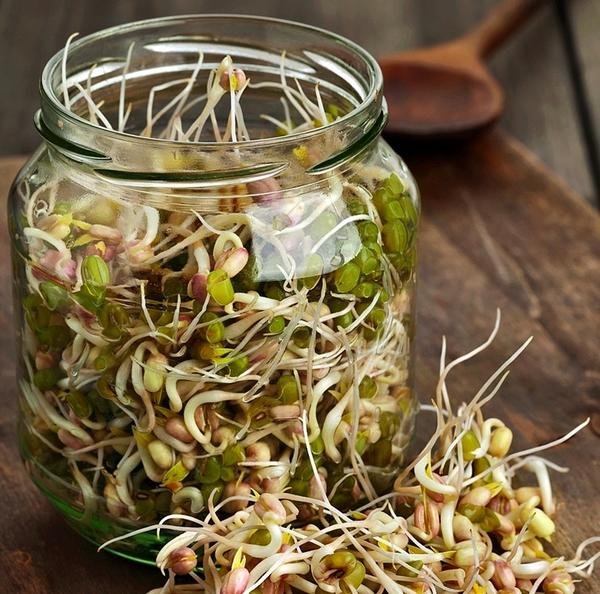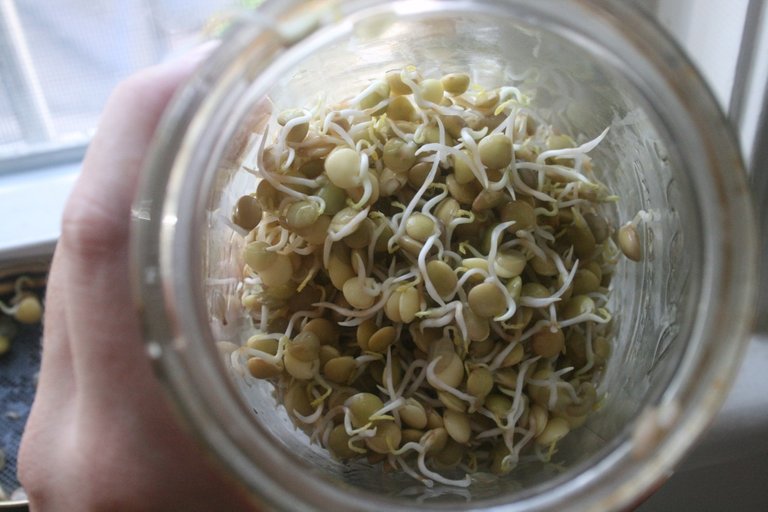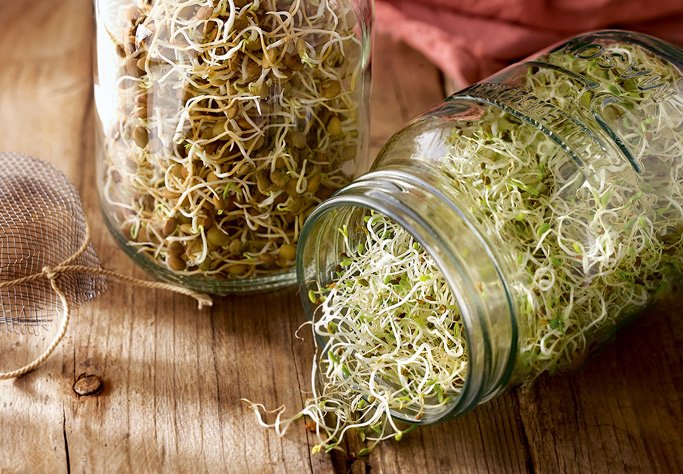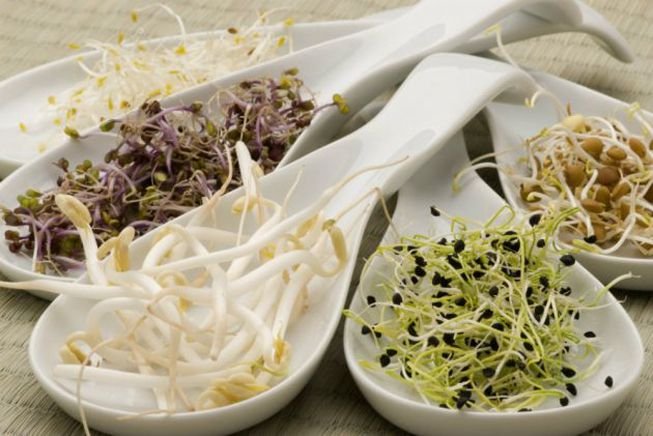source

Greetings dear community, again happy to share with you.
Today I want to share with you this topic as it is the germination, its benefits and nutritional information.
For thousands of years Asians have recommended the consumption of shoots to live more than 100 years. And it was not about living for many years, but about doing it with quality and free of diseases. The buds provide the organism, in addition to the enzymes (diastases) that are activated at the time of the development of the new seedling, part of the vital energy intrinsic to the new living organism.
When a grain of any cereal or legume has enough water, oxygen and heat germinates. Once sprouted they are more nutritious and easier to digest. Cereal grains and legumes are "concentrated" foods and, because of their low water content and their richness in complex carbohydrates -such as starch- and proteins, they should not be eaten raw. To make it easier for the body to assimilate, they are eaten cooked or roasted. With this, a kind of "pre-digestion" is carried out that our organism could not do on its own. The sprouts, on the other hand, are as if they had already reached that state.
Among its benefits:
- Rich in vitamins and minerals essential for our health.
- They are easily digested and assimilated by the body, according to our blood biotype.
- They are easy to do.
Nutritional report
* Essential amino acids.
Sprouts, especially legumes, provide the body with complete proteins that are transformed into the eight essential amino acids. The lack of one of these compounds can favor the appearance of allergies, weakness, poor digestion, deficiencies in immunity or premature aging of cells.
* Vitamin C.
One of the substances that increases the most by the effect of germination. The sprouts of wheat, lentils, soy, chickpeas and beans are excellent sources of this vitamin, for example the germinated soy increases its content of vitamin C up to 100% and the wheat sprouts by 600% in only 5 days.
* Beta carotenes (pro-vitamin A).
Alfalfa sprouts, for example, contain more beta carotenes than tomatoes or green peppers and many fruits. The sprouts of cabbage and peas are also excellent sources of this essential vitamin for growth, development, good eyesight and reproductive system.
* Vitamin B.
Thiamin (B1), riboflavin (B2) and niacin (B3) are abundant in the sprouts of alfalfa, wheat, sunflower, rye and sesame. Contribute to the proper functioning of the nervous system.
* Vitamin E.
This vitamin acts as a cellular antioxidant, is an excellent protector of the heart and a good toning. Germinated wheat reaches up to three times its content.
* Vitamin K.
It has coagulant properties, it is found in germinated alfalfa.
* Chlorophyll.
The germinated seeds that most chlorophyll synthesize are those of wheat and those of alfalfa. Chlorophyll is absorbed directly by the blood through the lymphatic system, in the bloodstream it activates the cellular metabolism, improves the defense, resistance, regenerative capacity of the cells, and respiration, among other properties, enhances the natural healing processes, it purifies the blood, stops infections and balances the acid-base ratio in the body.
* Calcium.
Sesame sprouts provide abundant calcium, almond, sunflower, alfalfa and chickpea sprouts are also excellent sources of this mineral.
* Potassium
It is found in almond, sesame, sunflower, soybean and bean sprouts.
* Iron.
They contain in large quantities the sprouts of alfalfa, fenugreek, lentils, red soybeans and green soybeans.
* Trace elements
Sprouts contain trace elements such as iodine, zinc, selenium, silicon, chromium and cobalt.
* Enzymes
When eaten raw the enzymes of the germinated seeds - called diastases - facilitate the digestion of fiber, proteins and fats.
* Digestive, nutritious and low-calorie.
They provide very few calories, for example 100 grams. of bean sprouts: 30 calories.
Nutritional information of the most consumed sprouts
Any leguminous seed or grain of cereal can be germinated, although, the most appreciated for their tenderness and good taste are the shoots of: legumes (mung beans, soybeans, alfalfa), cereals (wheat, barley) and also watercress, radish , pumpkin, sunflower, flax, sesame, etc. The flavor is variable, for example the one of alfalfa is very pleasant, the one of mustard is the most spicy and the one of wheat has sweet flavor by the carbohydrates that contains
* Alfalfa:
complete and more consumed for its pleasant flavor. It contains vitamins A, B, C, E and K, calcium, magnesium, potassium, iron, selenium and zinc and the most important amino acids. It is remineralizing, fights fatigue and weakness.
* Integral rice:
It is rich in vitamin B, phosphorus, potassium, magnesium, sodium, calcium and silicon. It helps the proper conservation of bones and teeth.
* Peas:
They provide chlorophyll, proteins, carbohydrates, fiber, vitamin A, iron, potassium and magnesium.
* Oats:
the most recommended germinated seed for nervous disorders, depression and sleep disturbances. It contains vitamins B and E, proteins, carbohydrates, fiber, minerals and a high silicon content, necessary for the development of muscular, cerebral and nervous structures.
* Watercress:
very suitable to combat the symptoms of spring fatigue. It alkalizes and purifies the blood, neutralizes the excess of toxins. Regulates the metabolism. It is rich in iron, phosphorus, manganese, copper, zinc, iodine, calcium and vitamins A, B2, E and C.
* Fenugreek:
blood and kidney cleanser, it is recommended to lift the mood down and to strengthen the body. Stimulate hepatic and digestive functions. It gives a pleasant smell to the sweat of those who consume it. It contains abundant phosphorus and iron.
* Chickpeas:
they are rich in carbohydrates, fiber, calcium, proteins, magnesium, potassium and vitamins A and C. They do not produce gases during digestion
* Lentils:
they delay aging and are rich in protein, vitamin C and iron.
* Corn:
high in magnesium, necessary to preserve muscle tension especially in the intestinal tract.
* Mustard:
suitable to treat digestive disorders such as gastritis, enteritis, etc. Rich in vitamin C, proteins and lipids.
* Mung beans:
are rich in vitamins A, C, and complex B.
* Pumpkin seeds:
contain protein, vitamin E, phosphorus, iron and zinc.
* Sunflower seeds:
rich in protein, unsaturated fats, vitamins B and E, calcium, iron, phosphorus, potassium and magnesium.
* Radish:
contains abundant chlorophyll, useful to combat heavy digestion and to calm cough.
* Sesame:
good source of fiber, proteins, vitamins B and E, magnesium, potassium, iron, phosphorus and calcium.
* Green soy:
contains proteins that give rise to the amino acid methionine, with a relaxing effect. Strengthens the nervous system and helps reduce excess cholesterol. They are rich in vitamins A, C, iron and potassium.
* Wheat:
is rich in protein, magnesium, phosphorus and vitamins B and E. Prevents infections, remineralizes, regenerates cells and serves to treat nervous disorders.
Properties
Sprouts help prevent diseases or treat them if they have already manifested. The following properties stand out:
- They favor the processes of detoxification, purification and elimination of residues stored in the tissues or in the blood.
- Strengthen the immune system.
- Antioxidants, fight the action of free radicals.
- Stimulate the secretions of the pancreas.
- They facilitate digestion, activate the processes of regeneration and disinflammation of the digestive system, revitalize the internal metabolic mechanisms.
- Improve intestinal function, relieve constipation, strengthen the intestine and intestinal flora, contribute to eliminate gases and waste.
- Lower the cholesterol level.
- Tone the nervous system.
- They contribute to maintain the elasticity of the arteries and the vitality of the glandular system.
- Delay aging, its components allow body cells to stay young for longer.
- They favor the metabolism for its restorative action.
- Its consumption is recommended in cases of anemia due to its richness in chlorophyll, and for people with a delicate stomach.

How to make germinates at home?
You need:
• 1 liter canned glass jar.
• 3 tablespoons of legumes, grains or seeds of choice, that have not been toasted or frozen (lentil, soy, wheat, amaranth, alfalfa, chickpea, etc.)
• 1/2 liter of water.
• Destiny a warm and dark space for germination.
preparation:
- Wash the legumes, grains or seeds and put them to soak in a jar with ½ liter of water. Cover the bottle with gauze or thin cloth.
- Leave the bottle in a dark and warm place, from 9 to 12 hrs. alfalfa and fenugreek and from 12 to 15 hrs. lentils, chickpeas, soy, etc.
- After the time, drain the water and rinse well with warm water.
- In the same space where the legumes, grains or seeds were left to rest, position the bottle horizontally (inclined), arranging the grains along the bottle, rinsing 2 to 3 times the first 3 days and then once a day . Keep the seeds moist and well oxygenated, otherwise, it could create fungus excess water and mold the lack of air.
- By the 4th-5th day you can see the first shoots. When the shoots are 2 to 3 centimeters long, expose to indirect sunlight for about 2 hours so that the leaves turn green (chlorophyll process). This will favor the increase of vitamin C and make it taste more pleasant.
- Once the germination process is finished, you can keep the sprouts refrigerated, well drained and dry. They can last without problems for about a week, it is recommended to make frequent amounts of sprouts.
- If desired, you can remove the husks (skins) of the legume before eating it, for that, place it inside a bucket with water and the shell will float. Remove with a strainer.
Tips to consider for sprouts and sprouts at home
- The germination time varies according to the temperature. In hotter and wetter climates, the soaking time should be shortened and rinsed more frequently to keep them cool. The temperature approx. It is 20 degrees.
- Avoid placing simultaneously more than one kind of seeds, grains or legumes in the same bottle, can germinate at different times, which hinders the processes.
• Use medium and / or large containers. The seeds increase in size and need to be "free", with space (Bottle 3 times the size of seeds, legumes and / or grains). You can use a container at the beginning and change it in the process.
• Prefers organic seeds, grains and legumes. (You can find them in toasters, free fairs, etc.)
• There is the possibility that seeds, legumes and grains remain ungerminated. Review them before preparing them and remove them.
• Sesame (sesame) buds become bitter if they are germinating more than two days, it is advisable to consume them no later than 48 hours after starting the soaking.
We must feed ourselves correctly opting to consume organic foods, including fruits and vegetables, for the proper functioning of our body.


Beautifully crafted post, we have indeed enjoyed reading this post, as we have equally learnt from this publication.
Resteem
The Capybara Exchange team is dismissed. Hello @enilekcays we really liked your post. We like sprouts, thanks to your post we can make them at home! :) and that's why we delivered this invitation link to the Discord Channel https://discord.gg/zFPWeVK, where you can exchange